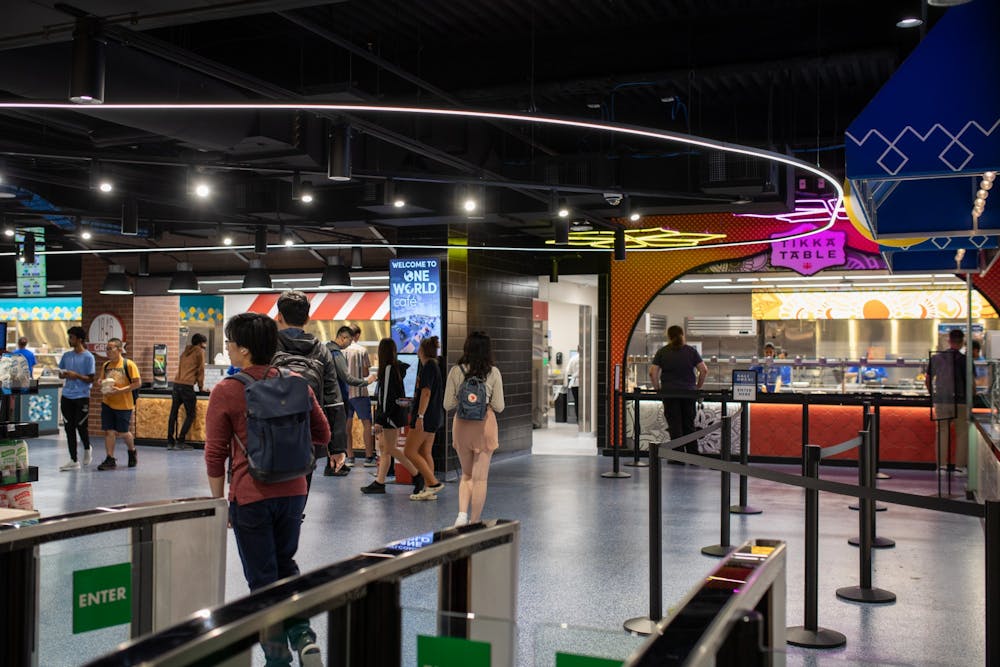*Editor’s note: The Spectrum spoke on the record to one student who is involved in Campus Dining and fears backlash from their employers. The Spectrum doesn’t usually grant anonymity to sources unless they “may face danger, retribution or other harm,” as enumerated in the SPJ Code of Ethics, but has made the decision to do so here in order to protect this person’s identity. The anonymous student will be referred to by the pseudonym of Wendy Smith throughout this story.
Throughout high school, Scarlett Topilow maintained a gluten-free diet for her celiac disease without trouble.
But since coming to UB, she has found it difficult to find places to eat that can accommodate her gluten-free diet. Topilow, a freshman business major, has had to deal with substitutes that are “cheap and nasty.”
Many students with food sensitivities have expressed that UB gives them limited options for substitutions, and in the cases where there are substitutions available, it is a very complicated process.
“They always have baked goods in C3, but there will never be good gluten-free baked goods. The only option they have is a very crumbly and tasteless brownie,” Topilow said. “It does get upsetting seeing cakes and cookies and pies, and then you’re sitting here with a brownie that literally falls apart when you touch it.”
Topilow says that there are a “decent amount” of gluten-free options on campus, but a lot of them don’t taste good.
“They have gluten-free pizza, but it’s like eating mushy cardboard that doesn’t have flavor,” she said. “Or they have gluten-free pasta but again, it’s like eating cardboard with sauce and cheese.”
Topilow is upset because there are “really great gluten-free kinds of pasta out there,” but believes the school doesn’t want to spend money on something that is more expensive.
“It would be great to have food that I could eat and actually enjoy, that’s not a game-changing request,” Topilow said.
Topilow isn’t alone. UB students with food allergies and intolerances said UB gives them limited and often complicated substitution options, leaving them feeling overlooked by the university.
Cross-contact issues
Wendy Smith*, a senior geology major who also has celiac disease, has gotten sick from cross-contact with gluten a handful of times this semester. One instance was so severe that she was hospitalized.
“Every single time I go to C3, I end up with food poisoning from cross-contamination [cross-contact],” Smith said. “In dining halls like C3 or even Goodyear’s Main St. Market, they [the workers] will go into the back and make the [gluten-free] food, but they’ll use utensils or a similar space that’s close enough to an area that’s being prepared with gluten.”
Students have also faced similar problems at One World Café, which she avoids.
“Almost every single place has horrible cross-contamination [cross-contact] or only has gluten. I haven’t even bothered with One World [Café],” Topilow said.
Samuel Magaseyev, a sophomore undecided major with a severe peanut and tree nut allergy, says Campus Dining workers aren’t knowledgeable enough about the ingredients of the food they’re serving to serve students with allergies.
“I went to the Indian place [Tikka Table] at One World Café, and I asked one of the workers, ‘Are there any nuts in any of this food or any cross-contamination [cross-contact]?’” Magaseyev said. “And the guy didn’t know what I was saying. His coworker kind of filled in for him and was like ‘No, no nuts.’ And then I scan one of the barcodes and it said ‘May contain peanuts.’”
The same incident repeated itself at Pan Asia in One World Café only weeks later.
Magaseyev says there is “a lot of inconsistency” with the workers, and believes that workers should be “trained better on how severe allergies are.” Their acts are not malicious, he says, but adds that workers’ mistakes could be life-threatening.
Cross-contact issues aren’t limited to the larger dining halls. Maximilian Atkins, who has a shrimp allergy, has had a few close call cross-contacts with shrimp at the Governor’s dining hall have forced the sophomore communication major to stay on his toes.
“There’s been a couple of times where there was cross-contamination [cross-contact]with my food,” Atkins said. “They [the workers] would always use the same tongs that they used to pick the shrimp, for everything else. They constantly mix it.”
“Campus Dining and Shops (CDS) managers are required to pass Menutrinfo’s Allertrain U certification course,” Raymond Kohl, director of marketing and communications for Campus Dining and Shops, said in an email to The Spectrum. “It is an ANAB-accredited, manager-level, gluten-free, and food allergy training course for colleges and universities.”
The training program focuses in large on cross-contact prevention.
CDS policy states that “all questions about food allergies, ingredients, recipes, and/or preparation methods should be directed toward a general manager, chef, or dietitian.”
Kohl stated that front-line and student employees are instructed to notify a manager if a customer states they have a food allergy or are gluten-free and that they should not answer allergy-related questions.
Students are also encouraged to alert a manager of their food allergies on the GET mobile app and self-ordering kiosks.
Labeling issues
Students have also faced problems with food labeling and QR codes that don’t work.
“You go to One World [Café] and the barcodes aren’t working and just don’t tell you what the food contains half the time,” Magaseyev said.
Magaseyev wants the QR code to show expanded lists of what ingredients the food contains. Most food items are only labeled as containing “more than one allergen” without further specificity.
Atkins has also experienced problems with food labeling on campus.
“In the Governor’s dining hall, there is a huge granola dispenser. It contains coconuts, cashews, and peanuts but there’s no sign,” Atkins said. “It has the ingredients faced toward the consumer, but it’s not in bold print and most people don’t read fine print.”
CDS “labels and flags all food that has allergy alerts for fried items and baked goods,” Kohl said.
Fried items are flagged with “cross-contact may occur in fryer” listed on NetNutrition and nutrition line signs. Areas with baked goods have purple allergen stickers reminding customers that they are produced in a facility that handles major allergens.
“This is an addition to labeling foods that contain any of the big nine allergens,” Kohl said.
CDS workers also have practices to reduce cross-contact in storage areas and in the placement of items on the service line.
“We group highly allergenic foods together or physically separate them from the service line,” Kohl said. “A great example is peanut butter and jelly sandwiches. They are prepared on a separate cutting board, physically away from other items.”
Long wait times
Even if they are able to reach a manager, students still have to wait to get their food specifically prepared.
“Today, I went to Sizzles and it took 40 minutes to get tater tots because there’s a specific air fryer [to use], and there are other people who need it, too. It’s very time-consuming,” Topilow said. “The issue with ordering ahead is I don’t always know when I’m going to eat because I’m studying and doing other things, so timing is very difficult.”
Extra precautions are taken to prepare allergen-free and gluten-free meals which may increase wait times, Kohl says.
“Students are encouraged to utilize the GET mobile app or arrive at locations during less busy times,” Kohl said.
When a manager is alerted that a customer has a food allergy, intolerance, and/or gluten-free they are trained to follow multiple steps to avoid cross-contact when preparing an allergen-free meal.
These steps include “washing hands and putting on new gloves, using dedicated equipment, and a special allergen-free food prep kit. The workers are also instructed to use fresh ingredients or backup ingredients that have not touched the service line,” Kohl said. “If a mistake (cross-contact) occurs during the preparation of the allergen-free meal, the manager must discard the meal and start over.”
Simple Kitchen
UB built and opened a new Simple Kitchen in the Governor’s Complex at the beginning of the semester for students with food allergies and sensitivities. The kitchen is “a pantry that is free from foods containing wheat, gluten, peanuts, tree nuts, fish and shellfish,” according to Kohl.
The space is meant to reduce the risk of cross-contact by providing dedicated equipment and verified ingredients for students to cook their own accommodated meals. The equipment includes storage areas, cookware, utensils, and a dedicated dishwasher to clean all cookware/utensils.
“To avoid cross-contact in this area we have the following policies: there is restricted access inside the pantry, no outside food is allowed to enter the pantry, and there is monthly allergen testing,” Kohl said.
Even though the Simple Kitchen was added to North Campus, students are pleading for more options across UB’s three campuses.
“I get that it’s super hard to deal with the 30,000 students here, but it is difficult to deal with [food sensitivities] on an individual basis as well for students,” Megan Kuhnel, a first-year higher education graduate student, said. “There needs to be more options.”
Morgan S.T. Ross contributed to the reporting for this story.
Victoria Hill is an assistant news/features editor and can be reached at victoria.hill@ubspectrum.com





